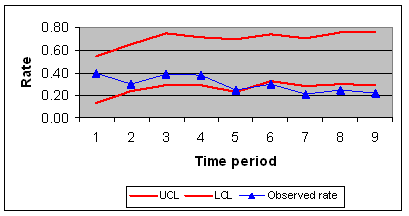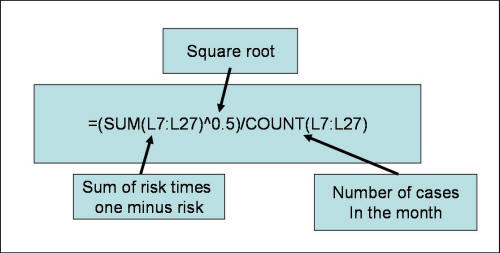Thank You
Thank you for submitting your data. This page provides you with correct
responses to selected assignments.
Presentation issues
A correction is needed if any of the following is present:
- The chart includes un-named labels such as "Series 1" and "Series
2."
- The markers in the control lines were not removed.
- The chart does not have a title
- The X-axis does not have a title
- The Y-axis does not have a title
- The chart is not easy to find.
- Colors used in the chart and in the cell values, do not help in
understanding of the work.
- Except for the data, all cell values should be calculated as a
formula. If this is not the case, it is very important that you
point this out. You should be able to change a data value and all
calculations should change automatically.
Accuracy
The chart should look like the following:

Figure 1; Control Chart for the Assignment
First notice the feel and look of the chart:
- Notice that the markers are removed from the UCL and LCL. They are
shown as lines as we want to attract attention to them as a line of limits
across time. In contrast the markers are shown in the observed rate
line because we want to make sure that it is looked at as individual
observations each time period.
- Notice that Observed rate and not the expected rate is plotted.
Many students plot the expected rate, which will always be within limits and
will not be informative.
- Notice that both the X-axis and the Y-axis are labeled
- Finally notice that the legend is available for the lines drawn in the
chart. None of the items in the legend is marked as "Series 1" or some
other automated text that does not make sense in this context.
Check that the Expected Deviation was calculated correctly. The
following shows the necessary calculations. I calculated the Expected Deviation by multiplying each
patients' risk factor with one minus the patients' risk factor. This is
what I got:
|
Month 1 |
Month 2 |
Month 3 |
Month 4 |
Month 5 |
Month 6 |
Month 7 |
Month 8 |
Month 9 |
|
0.1875 |
0.2475 |
0.24 |
0.1275 |
0.2475 |
0.1875 |
0.16 |
0.2275 |
0.24 |
|
0.24 |
0.1875 |
0.21 |
0.2475 |
0.24 |
0.2475 |
0.1275 |
0.16 |
0.25 |
|
0.21 |
0.24 |
0.24 |
0.21 |
0.2475 |
0.0475 |
0.09 |
0.25 |
0.1875 |
|
0.24 |
0.2475 |
0.2475 |
0.16 |
0.25 |
0.09 |
0.1875 |
0.2475 |
0.21 |
|
0.1275 |
0.16 |
0.21 |
0.2475 |
0.2275 |
0.25 |
0.24 |
0.1875 |
0.24 |
|
0.16 |
0.2275 |
0.24 |
0.24 |
0.2275 |
0.24 |
0.21 |
0.2275 |
0.2475 |
|
0.25 |
0.09 |
0.2475 |
0.1875 |
0.1875 |
0.21 |
0.24 |
0.24 |
0.21 |
|
0.25 |
0.25 |
0.21 |
0.09 |
0.2275 |
0.2275 |
0.2275 |
0.2475 |
0.1875 |
|
0.21 |
0.1875 |
0.2275 |
0.16 |
0.24 |
0.2275 |
0.25 |
0.21 |
0.16 |
|
0.16 |
0.2275 |
0.24 |
0.24 |
0.24 |
0.24 |
0.1875 |
0.2275 |
0.24 |
|
0.24 |
0.2275 |
0.0475 |
0.1875 |
0.2275 |
0.24 |
0.2275 |
0.1875 |
0.2475 |
|
0.21 |
0.16 |
0.1875 |
0.2275 |
0.09 |
0.1875 |
0.21 |
0.24 |
0.24 |
|
0.2475 |
0.2275 |
0.2475 |
0.16 |
0.24 |
0.1875 |
0.2475 |
0.2475 |
0.2275 |
|
0.1875 |
0.21 |
0.2275 |
0.1875 |
0.25 |
0.21 |
0.2275 |
0.2475 |
0.1875 |
|
0.1875 |
0.1875 |
0.21 |
0.24 |
0.1875 |
0.1875 |
0.21 |
0.2275 |
0.24 |
|
0.24 |
0.2475 |
0.24 |
0.16 |
0.2275 |
0.24 |
0.2275 |
0.1875 |
0.1875 |
|
0.2475 |
0.21 |
0.1875 |
0.1275 |
0.1875 |
0.1875 |
0.2275 |
0.24 |
0.2475 |
|
0.2275 |
0.25 |
0.1875 |
0.2475 |
0.2475 |
0.1875 |
0.24 |
0.1875 |
0.2475 |
|
0.1875 |
0.1875 |
|
0.25 |
0.21 |
0.2475 |
0.21 |
0.25 |
|
|
0.09 |
0.24 |
|
0.16 |
0.24 |
0.21 |
|
0.2275 |
|
|
|
|
|
0.2475 |
|
|
|
|
|
|
Table 1:
Risk times One Minus Risk |
Please notice that there are different number of patients in each time
period. When you copy and paste the formula, make sure that
the student did not go beyond the number of patients in that time period.
Then the student should have calculated the expected deviation in each time period by using the
following formula:

Figure 2: Formula for Calculation of Expected
Deviations from Table 1
Next you should have calculated the t-value. Because there are different number
of cases in each month, the t-value changes slightly. The t-values were
looked up in the table. The relevant portion of the table
is repeated here in Table 2. Please note that t-values are assessed
based on degrees of freedom which is equal to one minus the sample size.
|
Degrees of freedom |
t-value |
|
16 |
2.12 |
|
17 |
2.11 |
|
18 |
2.1 |
|
19 |
2.09 |
|
20 |
2.09 |
|
21 |
2.08 |
|
22 |
2.07 |
|
Table 2: Relevant t-values |
The control limits should be calculated from expected and not the
observed rates. This is a common mistake (look out for it). To the expected rates we add or subtract the value of t
times the standard deviation. The UCL and LCL values I calculated were as follows:
|
Month |
1 |
2 |
3 |
4 |
5 |
6 |
7 |
8 |
9 |
|
Observed rate |
0.40 |
0.30 |
0.39 |
0.38 |
0.25 |
0.30 |
0.21 |
0.25 |
0.22 |
|
Count |
20 |
20 |
18 |
21 |
20 |
20 |
19 |
20 |
18 |
|
Expected deviation |
0.10 |
0.10 |
0.11 |
0.10 |
0.11 |
0.10 |
0.10 |
0.11 |
0.11 |
|
Expected rate |
0.34 |
0.44 |
0.52 |
0.50 |
0.46 |
0.53 |
0.49 |
0.53 |
0.53 |
|
Degrees of freedom |
19 |
19 |
17 |
20 |
19 |
19 |
18 |
19 |
17 |
|
t-value |
2.09 |
2.09 |
2.11 |
2.09 |
2.09 |
2.09 |
2.10 |
2.09 |
2.11 |
|
UCL |
0.55 |
0.65 |
0.75 |
0.71 |
0.69 |
0.74 |
0.70 |
0.76 |
0.76 |
|
LCL |
0.13 |
0.23 |
0.29 |
0.29 |
0.23 |
0.32 |
0.28 |
0.30 |
0.29 |
|
Table 3: Calculation of Control
Limits |
Suggestions for Improvements
I hope this has been helpful feedback.
Copyright © 1996
Farrokh Alemi,
Ph.D. Created on Saturday, September 21, 1996. Most recent revision
05/03/2015. This
page is part of the course on
Quality/Process Improvement lecture on
Probability
Charts.
|